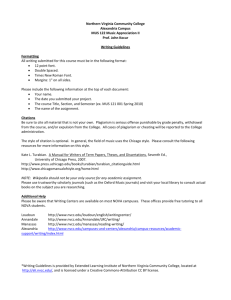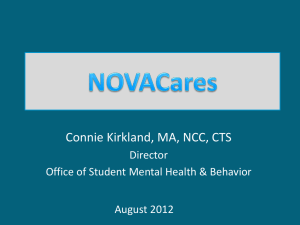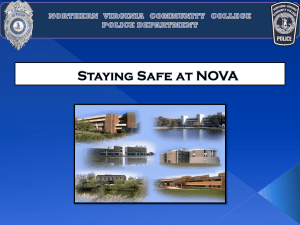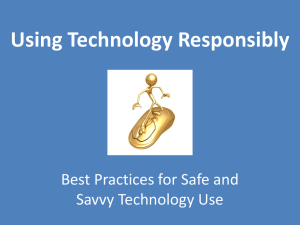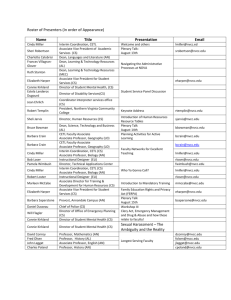Why Teach a Hybrid Course? - Northern Virginia Community College
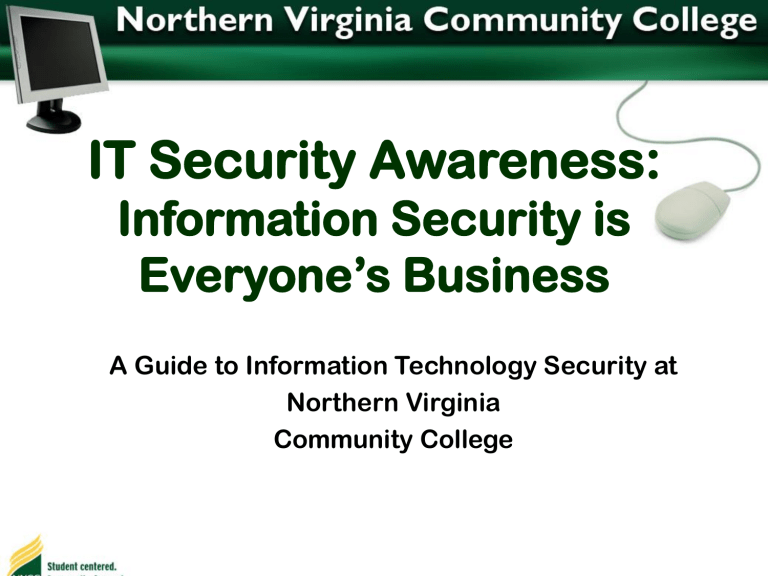
IT Security Awareness:
Information Security is
Everyone’s Business
A Guide to Information Technology Security at
Northern Virginia
Community College
Goals of IT Security
Awareness Training
To assist faculty and staff in using safe, secure computer practice to safeguard
College computing systems and data they store or access.
To answer any questions about information security requirements and procedures
To promote Computer Security Awareness
Information Technology
Security Awareness
What Is IT Security
Awareness?
Information Technology Security Awareness means understanding various information technology threats that exist in one's computing environment and taking reasonable steps to guard against them.
Who Is Responsible for IT
Security?
Everyone who uses a computer needs to know how to keep his or her computer and data secure to ensure a safe working environment.
NOTE: Security Awareness is one of the thirteen security components required in the COV ITRM
Standard SEC2001-01.1.
Who Must Have Security
Awareness Training?
All new employees who use information technology or have access to areas where information resources reside, must receive formal training within 30 days
Refresher training must be provided to all personnel annually at a minimum
What Are User Personal
Responsibilities?
Report security violations
Develop “end-of-day” security procedures
Practice proper telephone and e-mail security
Clear physical area in office of sensitive data when not in office
Do not leave your portable unattended
Lock your office, if possible
What Are the Consequences for Security Violations?
Risk to security and integrity of personal or confidential information
Los of employee and public trust resulting in embarrassment and bad publicity
Costly reporting requirements in case of compromise of sensitive information
Internal disciplinary action(s) up to and including termination of employment, possible penalties, prosecution, & potential for sanctions/lawsuits
What Must Be Included in the
Security Awareness Training
Program?
Provide both general and position appropriate security awareness content
Specify timeframes for receiving initial, ongoing and refresher training
Be documented on an auditable medium
Be approved by the Information Systems
Security Officer
How Is Security Awareness
Training Documented?
Receipt of training must be documented in employee’s personnel file with employee’s acknowledgement of receipt and understanding
All training must be documented and filed with
Information Systems Security Officer and available for audit
How Can Training Be
Delivered?
New employee orientation
General sessions
Departmental sessions
Web delivery via Web Pages, PowerPoint or video
Tip of the month via email to distribution lists
How Can Training Be
Delivered?
Posters
Brochures
“Security Day”
Brown bag lunch sessions
Computer Security
How Do I Secure My
Computer?
Use a firewall
Use strong passwords
Use antivirus software
Install security patches
Share files correctly
Back up files regularly
Don’t store sensitive information on hard drive
How Can I Prevent Spyware on my Computer?
Avoid free tool bars for your browser since they may come with spyware
Regularly use spam cleaners to remove spyware.
Using USB Drives Safely
How Do I Use USB Flash
Drives Safely?
Back up files on USB flash drive
Do not store sensitive data, such as SSNs or student grades, on USB flash drive
If possible, use password to protect data on
USB flash drive
Remember to remove drive from your computer before walking away
Safe Email Practice
What Is Safe Email Practice?
Don’t open email attachments unless you know what they are.
Don’t open, forward or reply to spam or suspicious emails; delete them.
Be aware of sure signs of scam email.
• Not addressed to you by name
• Asks for personal or financial information
• Asks you for password
• Asks you to forward it to lots of other people
Safe Email Practice
Don’t click on website addresses in emails unless you know what you are opening.
Use official VCCS student email to communicate with students about grades or to provide feedback on assignments.
Report email security concerns to IT Help Desk.
How Do I Recognize Phishing?
Phishing is type of email or instant message scam designed to steal your identity.
Phishing is the act of attempting to fraudulently acquire sensitive information, such as usernames, passwords, and credit card details, by masquerading as trustworthy entity in electronic communication using email or instant message.
How Can I Safeguard
Against Phishing?
Don’t reply to email or pop-up messages that ask for personal or financial information.
Don’t click on links in email or instant message.
Don’t cut and paste link from questionable message into your Web browser.
Use antivirus and firewalls and update them regularly.
Don’t email personal or financial information.
If you are scammed, visit Federal Trade
Commission’s Identity Theft website – www.consumer.gov/idtheft
Protecting Sensitive
Information
How Do I Protect Sensitive Data?
Protect sensitive information on lists and reports with social security numbers (SSNs).
Limit access to lists and reports with SSNs to those who specifically need SSNs for official college business.
Never store SSNs or lists with SSNs on laptops or home computers.
Save and store sensitive information on server managed by campus or college IT staff.
Protection of Sensitive Data
Never copy sensitive data to CDs, disks, or portable storage devices.
Do not sore lists with sensitive information on the Web.
Lock printed materials with sensitive data in drawers or cabinets when you leave at night.
When done with printed sensitive material, shred them.
Protection of Sensitive Data
Remove sensitive materials from printer right away.
If problem with printer, turn off printer to remove sensitive material from printer’s memory.
Personally deliver sensitive materials to recipient or distribute information electronically using
College’s email system.
Arrange for shared electronic file that requires user ID and password.
Password Security
Guidelines
What Are the Password
Security Guidelines?
Passwords must be treated as sensitive and confidential information.
Never share your password with anyone for any reason.
Passwords should not be written down, stored electronically, or published.
Password Security Guidelines
Be sure to change initial passwords, password resets and default passwords first time you log in.
Use different passwords for your different accounts.
Create passwords that are
• not common,
• avoid common keyboard sequences,
• contain personal information, such as pets & birthdays.
Top Ten List of
Good Computing
Practices
What Are the Steps to Take to Ensure Safe Computing?
Use cryptic passwords that can’t be easily guessed and protect your passwords.
Secure your area, files and portable equipment before leaving them unattended.
Make sure your computer is protected with anti-virus and all security patches and updates.
Steps to Ensure Safe Computing
Make backup copies of data you do not want to lose and store the copies very securely.
Don’t save sensitive information on portable devises, such as laptops, memory sticks, PDAs data phones, CDs/DVDs.
Practice safe emailing.
Be responsible when using the Internet.
Steps to Ensure Safe Computing
Don’t install unknown or suspicious programs on your computer.
Prevent illegal duplication of proprietary software.
Protect against sypware/adware.
How Should I Report
Security Incidents?
Immediately report suspected security incidents & breaches to your supervisor and the IT Help Desk.
Resources
Resource Handout
Use the handout found on the IT Security
Awareness Training website as easy reference for steps to follow to ensure information security.
College and Campus
Resources
Contact the IT HelpDesk ithelpdesk@nvcc.vccs.edu
703-426-4141
Contact the Office of Instructional & Information
Technology Support Services
703-323-3278
Contact your campus Information Technology
Manager (ITMs)
Campus IT Staff Contacts
Dave Babel (AL) dbabel@nvcc.vccs.edu
703-845-6019
Bruce Ghofrany (AN) bghofrany@nvcc.edu
323-4259
Jeff Howlett (MEC) jhowlett@nvcc.vccs.edu
703-822-6666
Kevin Kelley (LO) kkelley@nvcc.edu
703-450-2569
Lynn Bowers (MA) lbowers@nvcc.vccs.edu
703-257-6652
Lynn Feist (WO) nvfeisl@nvcc.vccs.edu
703-878-5659
Peter Tharp (CS) ptharp@nvcc.vccs.edu
703-323-3705
Tom Pyron (ELI) jpyron@nvcc.edu
703-323-3800
